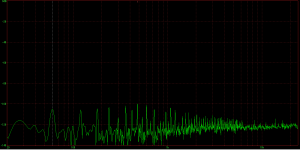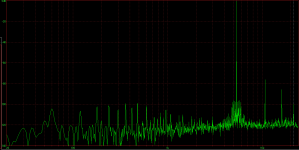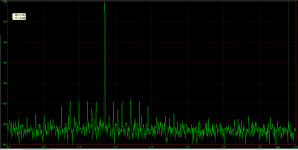Just for kicks I measured my HK3490 stereo receiver digital input as I was taking some measurements on some other equipment and now that I have seen this I cant sleep. What could cause this jitter type distortion and is the level high enough for concern ? There are 5 harmonics on either side of the 5Khz test signal and they are exactly 120hz apart.
I have attached 3 screen shots. First is just the noise floor with no signal. Second is ~5khz spectrum and the last is the same zoomed in to show the 120hz ripple on either side of the fundamental. Could this be due to insufficient (non-existent) shielding of the clock and dac components ?
I was also not expecting a long train of 60hz harmonics in the no signal test. what could be a reason for this ? It seems like the reciever has adequate filtering and regulation everywhere so what could cause this ? btw, this particular effect is on analog inputs as well and not just digital.
I have attached 3 screen shots. First is just the noise floor with no signal. Second is ~5khz spectrum and the last is the same zoomed in to show the 120hz ripple on either side of the fundamental. Could this be due to insufficient (non-existent) shielding of the clock and dac components ?
I was also not expecting a long train of 60hz harmonics in the no signal test. what could be a reason for this ? It seems like the reciever has adequate filtering and regulation everywhere so what could cause this ? btw, this particular effect is on analog inputs as well and not just digital.
Attachments
Ok all that stuff is down in the grass 100dB or so down, not great but hardly sleep deprivingly horrible.
The first is probably power supply related, it don't take much to leak a little power harmonics 100dB down into consumer gear.
What happens to the other plots if you reduce the input level by say 10dB?
How are you supplying the digital signal? If spdif on coax, could there be some ground current flowing in the shield?
I raise this because you would expect the noise spectrum to drop off at the loop filter bandwidth of the PLL if it was effectively jitter on the input, and looking at your tone spectra we do indeed see a sharp drop in the level of the spikes a KHz or so either side of the tone.
When making any measurements in the frequency domain it is worth running plots with a couple of different input levels, so that you can try to at least limit systematic issues (And 100dB down in the audio band, systematic issues can be hard to eliminate).
Regards, Dan.
The first is probably power supply related, it don't take much to leak a little power harmonics 100dB down into consumer gear.
What happens to the other plots if you reduce the input level by say 10dB?
How are you supplying the digital signal? If spdif on coax, could there be some ground current flowing in the shield?
I raise this because you would expect the noise spectrum to drop off at the loop filter bandwidth of the PLL if it was effectively jitter on the input, and looking at your tone spectra we do indeed see a sharp drop in the level of the spikes a KHz or so either side of the tone.
When making any measurements in the frequency domain it is worth running plots with a couple of different input levels, so that you can try to at least limit systematic issues (And 100dB down in the audio band, systematic issues can be hard to eliminate).
Regards, Dan.
Connection was optical. Measurement was made by laptop/soundcard running on battery.
Yes I did measure at different levels. I'd say -10 db or so there wasn't much different but at lower levels those sidebands seemed to disappear. Not sure if they were getting buried under the noise floor or they really weren't present.
Granted all that crap is way down there but bugs me that it's even there considering most measurements I have seen in reviews and tests of other dacs and amps are usually so clean.
Yes I did measure at different levels. I'd say -10 db or so there wasn't much different but at lower levels those sidebands seemed to disappear. Not sure if they were getting buried under the noise floor or they really weren't present.
Granted all that crap is way down there but bugs me that it's even there considering most measurements I have seen in reviews and tests of other dacs and amps are usually so clean.
Last edited:
And I have verified that the source nor the measurement apparatus has this jitter type artefact.
My main question is what are possible causes of that 120hz jitter type sidebands ?
Another strange thing I noticed when I hooked up load resistors instead of speakers to the amp and ran some test tones through that even at low to moderate power levels I could hear the test tones (1khz, 5khz) from the amp itself although quite faint. Something (transformer ? output transistors ?) was buzzing at the same frequency as the tone. What explains that ? The EI transformer in there would also increase its level of hum as I increased the power. Is that to be expected ?
My main question is what are possible causes of that 120hz jitter type sidebands ?
Another strange thing I noticed when I hooked up load resistors instead of speakers to the amp and ran some test tones through that even at low to moderate power levels I could hear the test tones (1khz, 5khz) from the amp itself although quite faint. Something (transformer ? output transistors ?) was buzzing at the same frequency as the tone. What explains that ? The EI transformer in there would also increase its level of hum as I increased the power. Is that to be expected ?
Last edited:
I was also not expecting a long train of 60hz harmonics in the no signal test. what could be a reason for this ? It seems like the reciever has adequate filtering and regulation everywhere so what could cause this ?
A couple of possibilities - one is that the wires from the trafo carrying capacitor charging currents have mutual inductance with other parts of your circuit. Another is that those charging currents flow through conductors which share paths (usually grounds) with other sensitive circuit loops.
The solution to the first is tight twisting of conductor pairs and ensuring they only cross at right angles. Fixing the second needs rigorous implementation of star grounding techniques.
- Status
- Not open for further replies.


